Abstract
Time-kill studies were used to examine the in vitro activities of penicillin G, RP 59500, erythromycin, ciprofloxacin, sparfloxacin, and vancomycin against 10 pneumococci expressing various degrees of susceptibility to penicillin and erythromycin. RP 59500 MICs for all strains were 0.5 to 2.0 micrograms/ml, while erythromycin MICs were 0.008 to 0.06 microgram/ml for erythromycin-susceptible strains and 32.0 to 64.0 micrograms/ml for erythromycin-resistant strains. Strains were more susceptible to sparfloxacin (0.125 to 0.5 microgram/ml) than to ciprofloxacin (0.5 to 4.0 micrograms/ml), and all were inhibited by vancomycin at MICs of 0.25 to 0.5 microgram/ml. Time-kill studies showed that antibiotic concentrations greater than the MIC were bactericidal for each strain, with the following exceptions. Erythromycin was bactericidal for one penicillin-resistant strain at 6 h, with regrowth after 12 and 24 h. Three penicillin-susceptible strains were bacteriostatically inhibited by erythromycin at concentrations greater than or equal to the MIC by 6 h. One penicillin-susceptible strain (penicillin MIC, 0.06 microgram/ml) was bacteriostatically inhibited by penicillin G at 24 h at the MIC or at one-half the MIC; a bactericidal effect was found only with penicillin G at concentrations of > or = 0.25 microgram/ml. At 10 min after inoculation a 1- to 3-log10-unit reduction (90 to 99.9%) in the original inoculum was seen for 6 of 10 strains with RP 59500 at concentrations greater than or equal to the MIC. This effect was not found with any of the other compounds tested. A bactericidal effect was found at > or = 6 h with RP 59500 at concentrations of one-half to one-quarter the MIC in 7 of 10 strains, and a bacteriostatic effect was found in 3 or 10 strains, with regrowth at 24 h. One penicillin-resistant strain was examined by the time-kill methodology at 0, 1, 2, and 3 h. RP 59500 at a concentration equal to the MIC was bactericidal within 1 h, and at a concentration of one-half the MIC it was bactericidal within 3 h. This phenomenon was not seen with the other antimicrobial agents tested. Regrowth of strains at ciprofloxacin concentrations equal to the MIC or at a one-half to one-quarter the MIC was found. For sparfloxacin, three of the four penicillin-susceptible strains and two of four penicillin-resistant strains were bacteriostatically inhibited by 6 h. Bactericidal effects were found at 6, 12, and 24 h with both intermediate-resistant, one penicillin-susceptible, and two penicillin-resistant strains. Complete killing was observed with vancomycin at concentrations greater than MIC. Of the new compounds tested, RP 59500 and sparfloxacin show promise for the treatment of infections caused by penicillin-susceptible and -resistant pneumococci. The clinical significance of rapid killing by RP 59500 remains to be determined.
Full text
PDF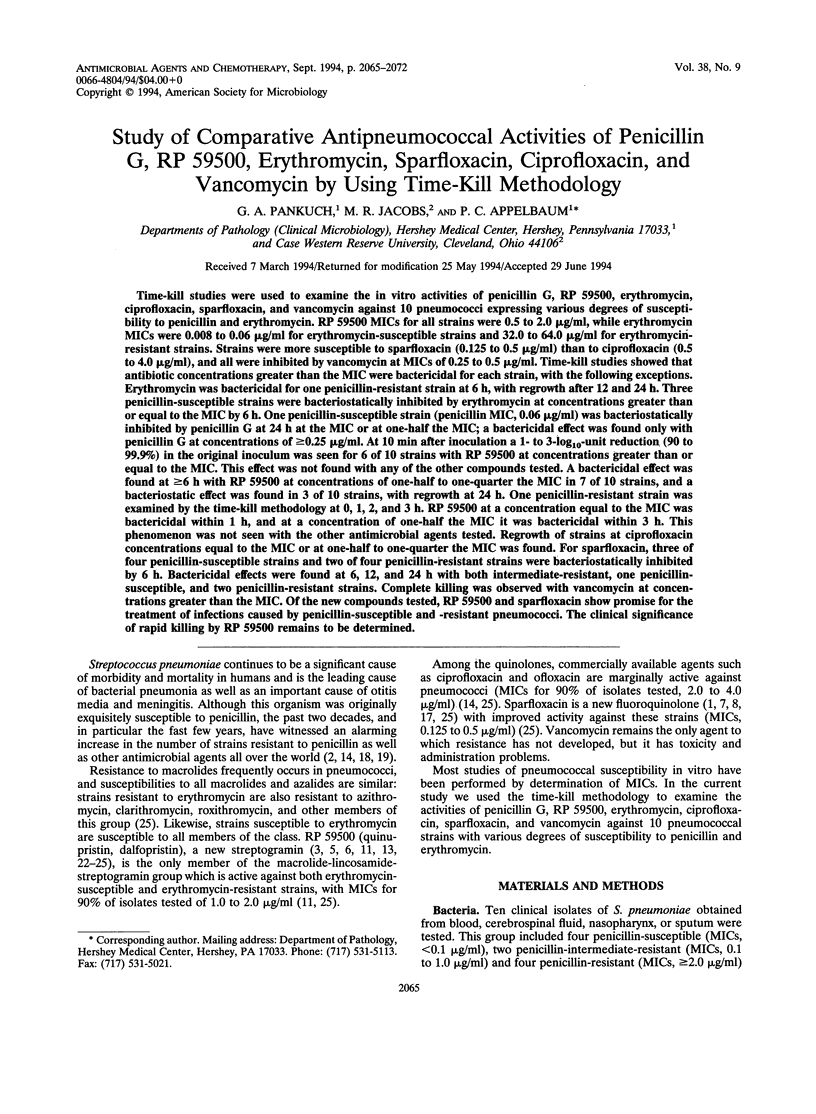
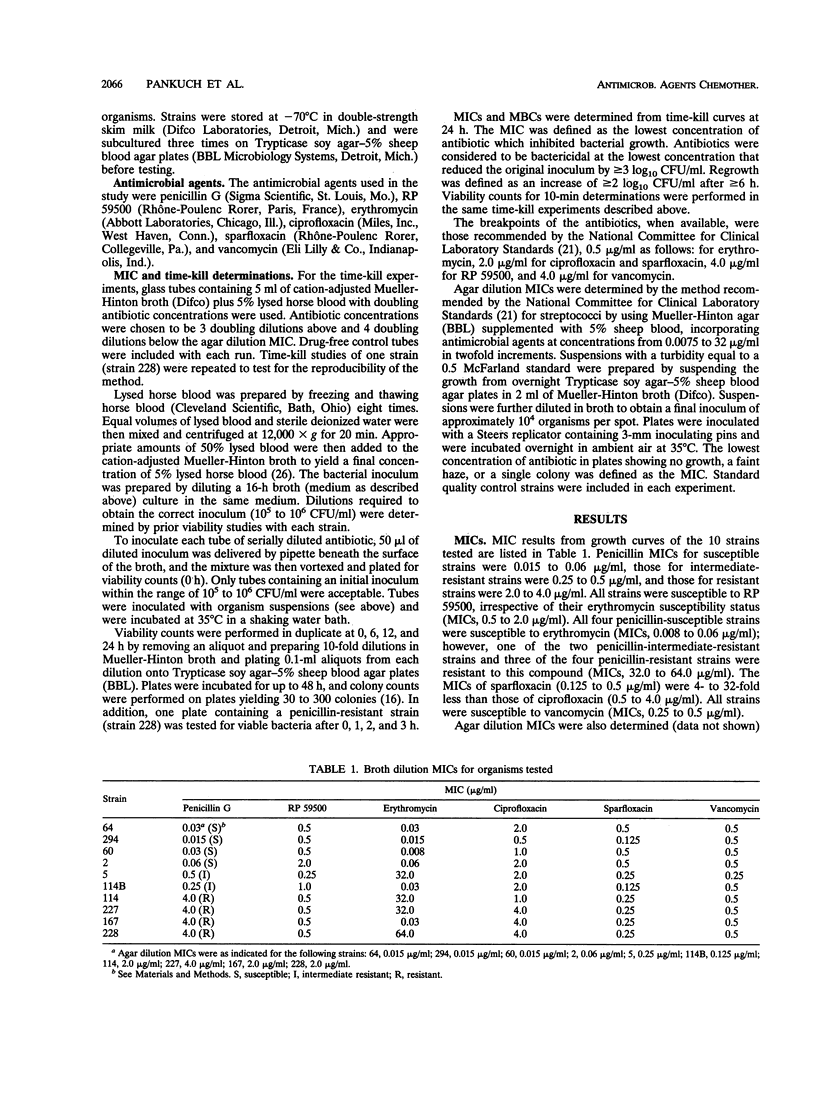
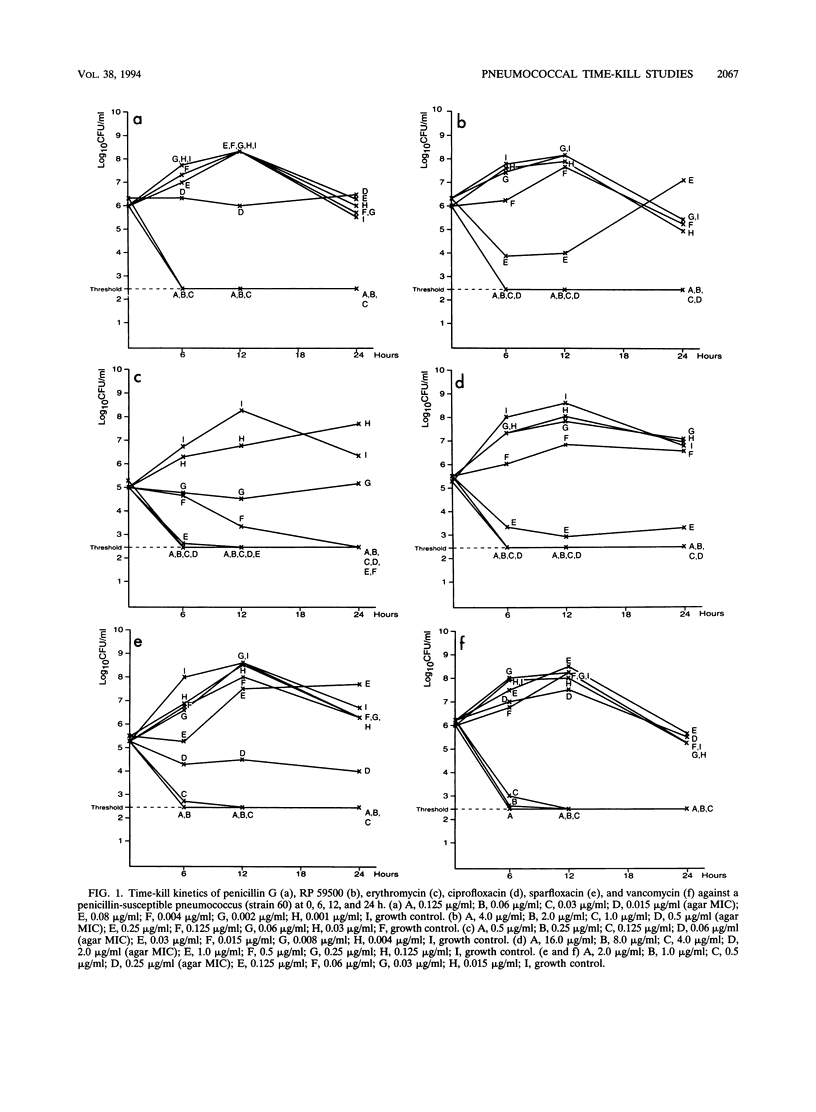
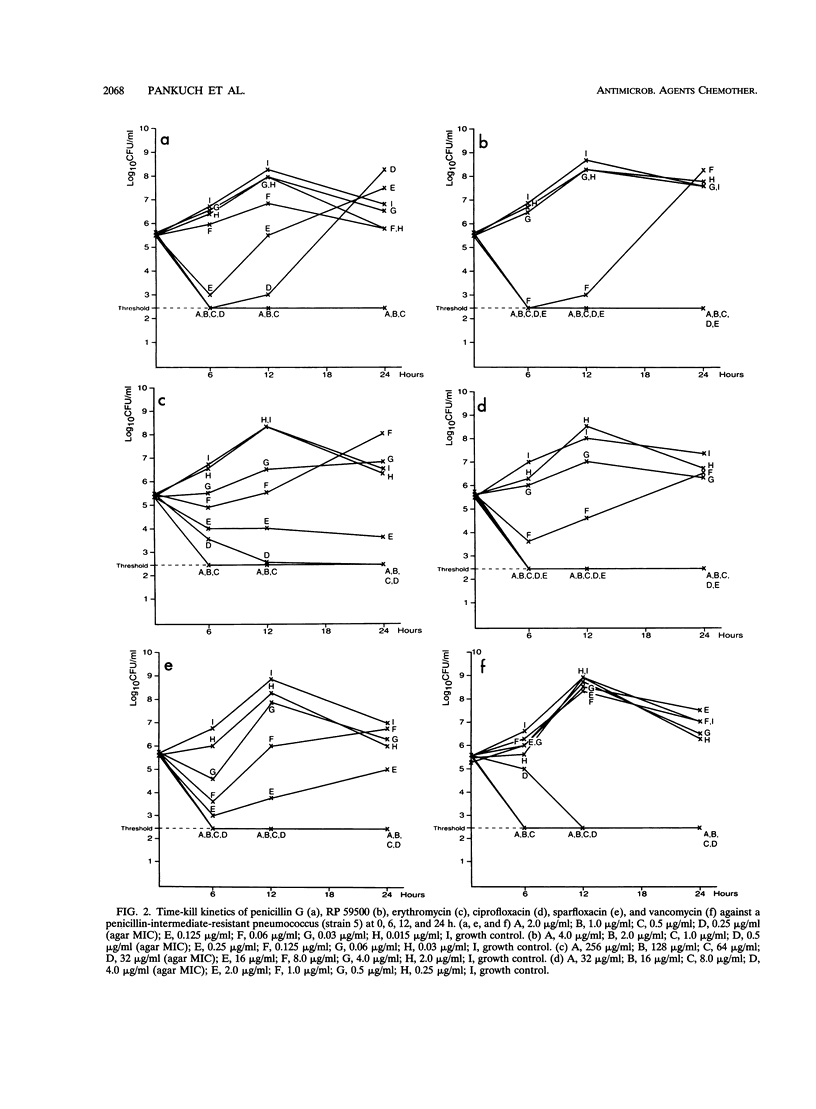
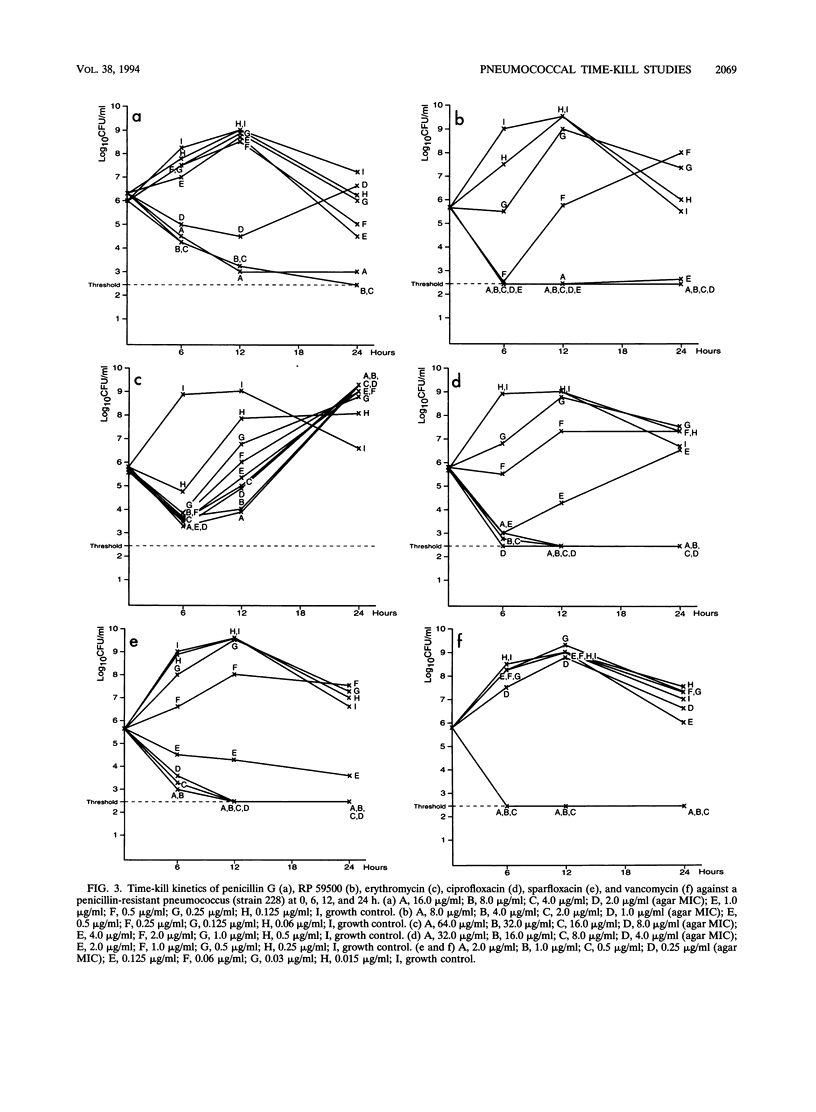
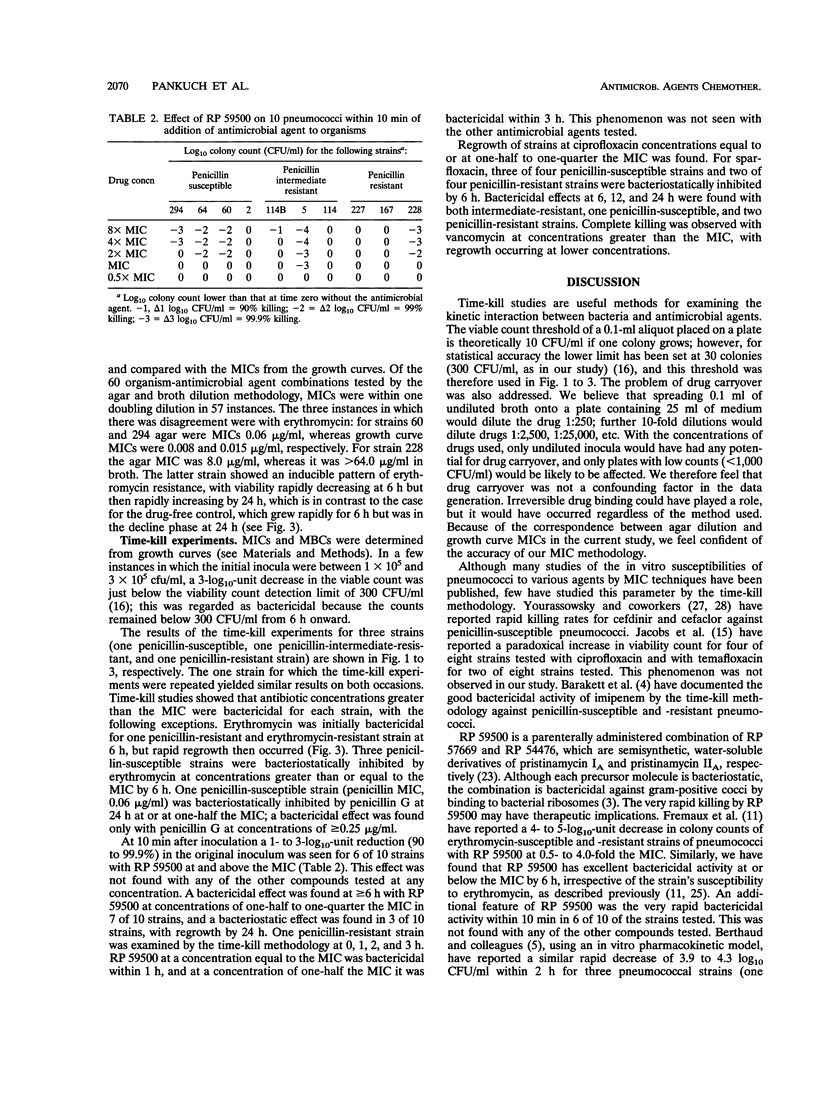
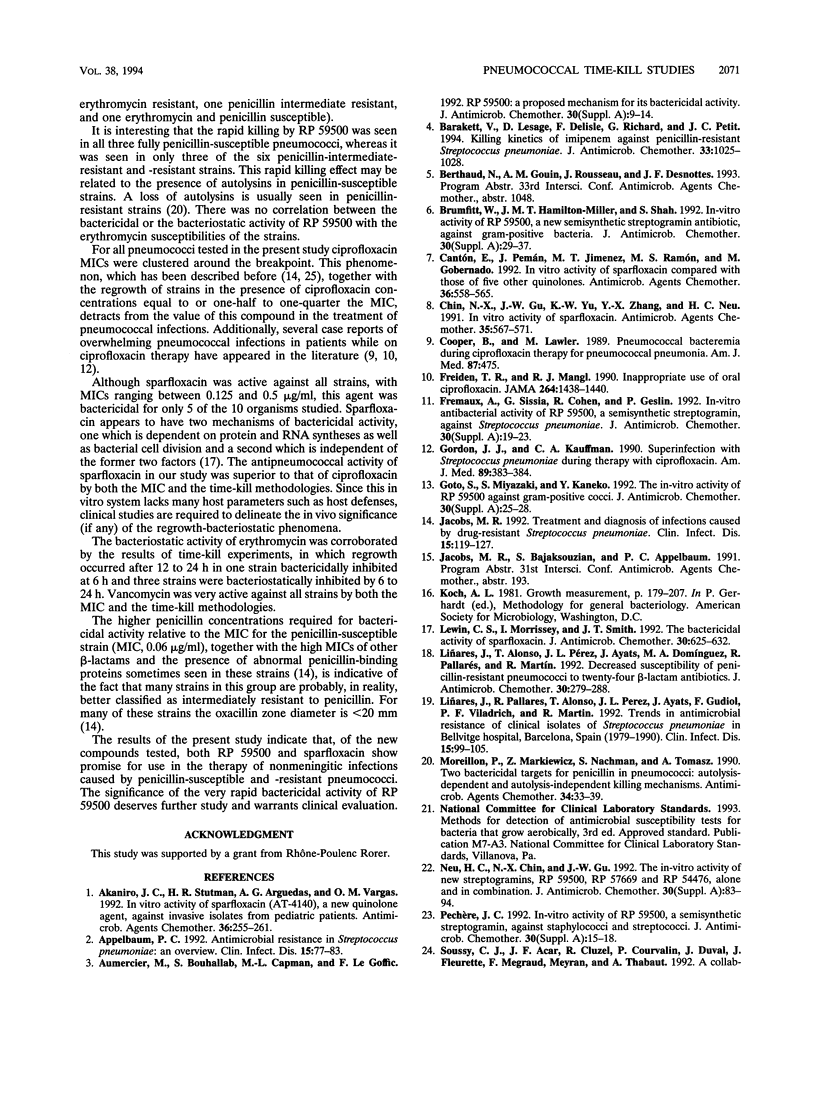
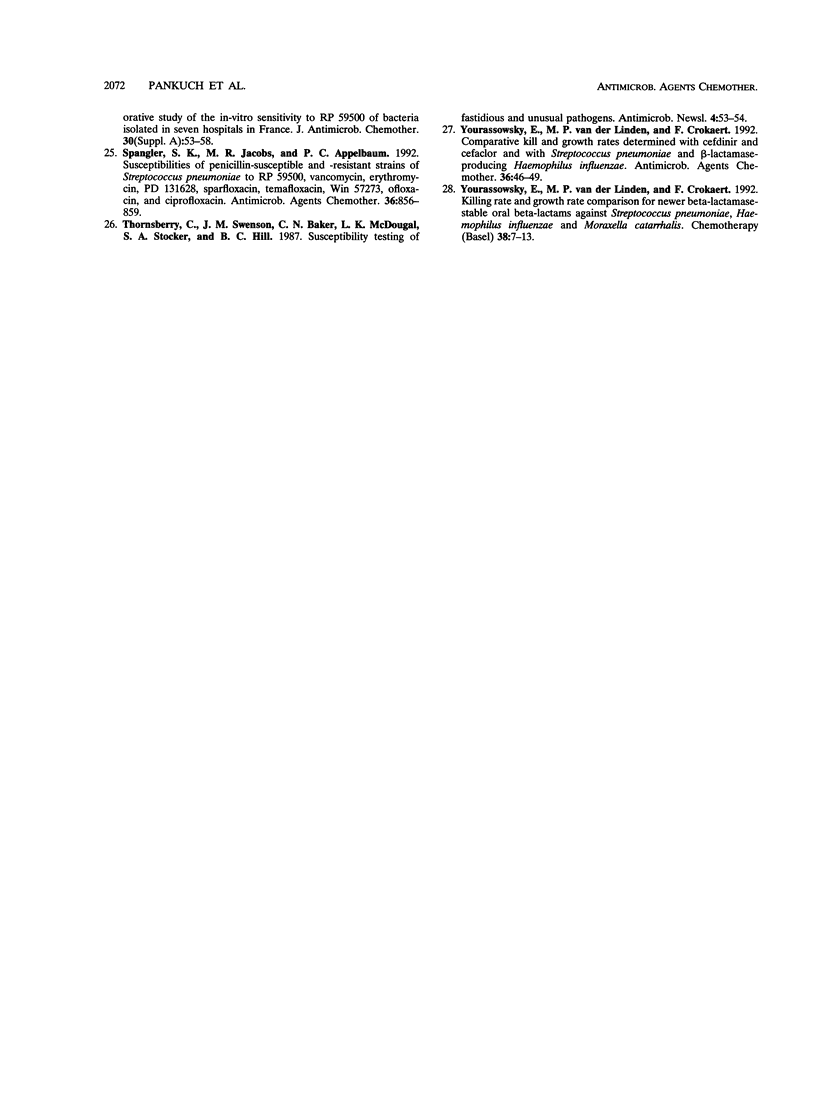
Selected References
These references are in PubMed. This may not be the complete list of references from this article.
- Akaniro J. C., Stutman H. R., Arguedas A. G., Vargas O. M. In vitro activity of sparfloxacin (AT-4140), a new quinolone agent, against invasive isolates from pediatric patients. Antimicrob Agents Chemother. 1992 Feb;36(2):255–261. doi: 10.1128/aac.36.2.255. [DOI] [PMC free article] [PubMed] [Google Scholar]
- Appelbaum P. C. Antimicrobial resistance in Streptococcus pneumoniae: an overview. Clin Infect Dis. 1992 Jul;15(1):77–83. doi: 10.1093/clinids/15.1.77. [DOI] [PubMed] [Google Scholar]
- Aumercier M., Bouhallab S., Capmau M. L., Le Goffic F. RP 59500: a proposed mechanism for its bactericidal activity. J Antimicrob Chemother. 1992 Jul;30 (Suppl A):9–14. doi: 10.1093/jac/30.suppl_a.9. [DOI] [PubMed] [Google Scholar]
- Barakett V., Lesage D., Delisle F., Richard G., Petit J. C. Killing kinetics of imipenem against penicillin-resistant Streptococcus pneumoniae. J Antimicrob Chemother. 1994 May;33(5):1025–1028. doi: 10.1093/jac/33.5.1025. [DOI] [PubMed] [Google Scholar]
- Brumfitt W., Hamilton-Miller J. M., Shah S. In-vitro activity of RP 59500, a new semisynthetic streptogramin antibiotic, against gram-positive bacteria. J Antimicrob Chemother. 1992 Jul;30 (Suppl A):29–37. doi: 10.1093/jac/30.suppl_a.29. [DOI] [PubMed] [Google Scholar]
- Cantón E., Pemán J., Jimenez M. T., Ramón M. S., Gobernado M. In vitro activity of sparfloxacin compared with those of five other quinolones. Antimicrob Agents Chemother. 1992 Mar;36(3):558–565. doi: 10.1128/aac.36.3.558. [DOI] [PMC free article] [PubMed] [Google Scholar]
- Chin N. X., Gu J. W., Yu K. W., Zhang Y. X., Neu H. C. In vitro activity of sparfloxacin. Antimicrob Agents Chemother. 1991 Mar;35(3):567–571. doi: 10.1128/aac.35.3.567. [DOI] [PMC free article] [PubMed] [Google Scholar]
- Cooper B., Lawlor M. Pneumococcal bacteremia during ciprofloxacin therapy for pneumococcal pneumonia. Am J Med. 1989 Oct;87(4):475–475. doi: 10.1016/s0002-9343(89)80838-1. [DOI] [PubMed] [Google Scholar]
- Fremaux A., Sissia G., Cohen R., Geslin P. In-vitro antibacterial activity of RP 59500, a semisynthetic streptogramin, against Streptococcus pneumoniae. J Antimicrob Chemother. 1992 Jul;30 (Suppl A):19–23. doi: 10.1093/jac/30.suppl_a.19. [DOI] [PubMed] [Google Scholar]
- Frieden T. R., Mangi R. J. Inappropriate use of oral ciprofloxacin. JAMA. 1990 Sep 19;264(11):1438–1440. [PubMed] [Google Scholar]
- Gordon J. J., Kauffman C. A. Superinfection with Streptococcus pneumoniae during therapy with ciprofloxacin. Am J Med. 1990 Sep;89(3):383–384. doi: 10.1016/0002-9343(90)90355-h. [DOI] [PubMed] [Google Scholar]
- Goto S., Miyazaki S., Kaneko Y. The in-vitro activity of RP 59500 against gram-positive cocci. J Antimicrob Chemother. 1992 Jul;30 (Suppl A):25–28. doi: 10.1093/jac/30.suppl_a.25. [DOI] [PubMed] [Google Scholar]
- Jacobs M. R. Treatment and diagnosis of infections caused by drug-resistant Streptococcus pneumoniae. Clin Infect Dis. 1992 Jul;15(1):119–127. doi: 10.1093/clinids/15.1.119. [DOI] [PubMed] [Google Scholar]
- Lewin C. S., Morrissey I., Smith J. T. The bactericidal activity of sparfloxacin. J Antimicrob Chemother. 1992 Nov;30(5):625–632. doi: 10.1093/jac/30.5.625. [DOI] [PubMed] [Google Scholar]
- Liñares J., Alonso T., Pérez J. L., Ayats J., Domínguez M. A., Pallarés R., Martín R. Decreased susceptibility of penicillin-resistant pneumococci to twenty-four beta-lactam antibiotics. J Antimicrob Chemother. 1992 Sep;30(3):279–288. doi: 10.1093/jac/30.3.279. [DOI] [PubMed] [Google Scholar]
- Liñares J., Pallares R., Alonso T., Perez J. L., Ayats J., Gudiol F., Viladrich P. F., Martin R. Trends in antimicrobial resistance of clinical isolates of Streptococcus pneumoniae in Bellvitge Hospital, Barcelona, Spain (1979-1990). Clin Infect Dis. 1992 Jul;15(1):99–105. doi: 10.1093/clinids/15.1.99. [DOI] [PubMed] [Google Scholar]
- Moreillon P., Markiewicz Z., Nachman S., Tomasz A. Two bactericidal targets for penicillin in pneumococci: autolysis-dependent and autolysis-independent killing mechanisms. Antimicrob Agents Chemother. 1990 Jan;34(1):33–39. doi: 10.1128/aac.34.1.33. [DOI] [PMC free article] [PubMed] [Google Scholar]
- Neu H. C., Chin N. X., Gu J. W. The in-vitro activity of new streptogramins, RP 59500, RP 57669 and RP 54476, alone and in combination. J Antimicrob Chemother. 1992 Jul;30 (Suppl A):83–94. doi: 10.1093/jac/30.suppl_a.83. [DOI] [PubMed] [Google Scholar]
- Pechère J. C. In-vitro activity of RP 59500, a semisynthetic streptogramin, against staphylococci and streptococci. J Antimicrob Chemother. 1992 Jul;30 (Suppl A):15–18. doi: 10.1093/jac/30.suppl_a.15. [DOI] [PubMed] [Google Scholar]
- Spangler S. K., Jacobs M. R., Appelbaum P. C. Susceptibilities of penicillin-susceptible and -resistant strains of Streptococcus pneumoniae to RP 59500, vancomycin, erythromycin, PD 131628, sparfloxacin, temafloxacin, win 57273, ofloxacin, and ciprofloxacin. Antimicrob Agents Chemother. 1992 Apr;36(4):856–859. doi: 10.1128/aac.36.4.856. [DOI] [PMC free article] [PubMed] [Google Scholar]
- Yourassowsky E., Van der Linden M. P., Crokaert F. Comparative kill and growth rates determined with cefdinir and cefaclor and with Streptococcus pneumoniae and beta-lactamase-producing Haemophilus influenzae. Antimicrob Agents Chemother. 1992 Jan;36(1):46–49. doi: 10.1128/aac.36.1.46. [DOI] [PMC free article] [PubMed] [Google Scholar]
- Yourassowsky E., Van der Linden M. P., Crokaert F. Killing rate and growth rate comparison for newer beta-lactamase-stable oral beta-lactams against Streptococcus pneumoniae, Haemophilus influenzae and Moraxella catarrhalis. Chemotherapy. 1992;38(1):7–13. doi: 10.1159/000238935. [DOI] [PubMed] [Google Scholar]


